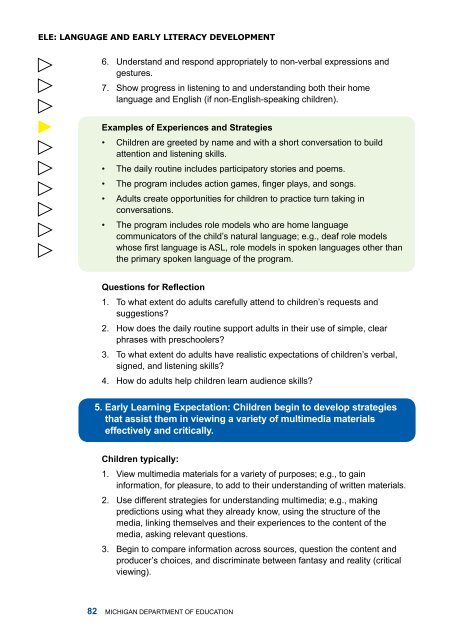Early Childhood Standards of Quality for ... - State of Michigan
Early Childhood Standards of Quality for ... - State of Michigan
Early Childhood Standards of Quality for ... - State of Michigan
Create successful ePaper yourself
Turn your PDF publications into a flip-book with our unique Google optimized e-Paper software.
ELE: Language and <strong>Early</strong> Literacy Development6. Understand and respond appropriately to non-verbal expressions andgestures.7. Show progress in listening to and understanding both their homelanguage and English (if non-English-speaking children).Examples <strong>of</strong> Experiences and Strategies• Children are greeted by name and with a short conversation to buildattention and listening skills.• The daily routine includes participatory stories and poems.• The program includes action games, finger plays, and songs.• Adults create opportunities <strong>for</strong> children to practice turn taking inconversations.• The program includes role models who are home languagecommunicators <strong>of</strong> the child’s natural language; e.g., deaf role modelswhose first language is ASL, role models in spoken languages other thanthe primary spoken language <strong>of</strong> the program.Questions <strong>for</strong> Reflection1. To what extent do adults carefully attend to children’s requests andsuggestions?2. How does the daily routine support adults in their use <strong>of</strong> simple, clearphrases with preschoolers?3. To what extent do adults have realistic expectations <strong>of</strong> children’s verbal,signed, and listening skills?4. How do adults help children learn audience skills?5. <strong>Early</strong> Learning Expectation: Children begin to develop strategiesthat assist them in viewing a variety <strong>of</strong> multimedia materialseffectively and critically.Children typically:1. View multimedia materials <strong>for</strong> a variety <strong>of</strong> purposes; e.g., to gainin<strong>for</strong>mation, <strong>for</strong> pleasure, to add to their understanding <strong>of</strong> written materials.2. Use different strategies <strong>for</strong> understanding multimedia; e.g., makingpredictions using what they already know, using the structure <strong>of</strong> themedia, linking themselves and their experiences to the content <strong>of</strong> themedia, asking relevant questions.3. Begin to compare in<strong>for</strong>mation across sources, question the content andproducer’s choices, and discriminate between fantasy and reality (criticalviewing).82 <strong>Michigan</strong> Department <strong>of</strong> Education


